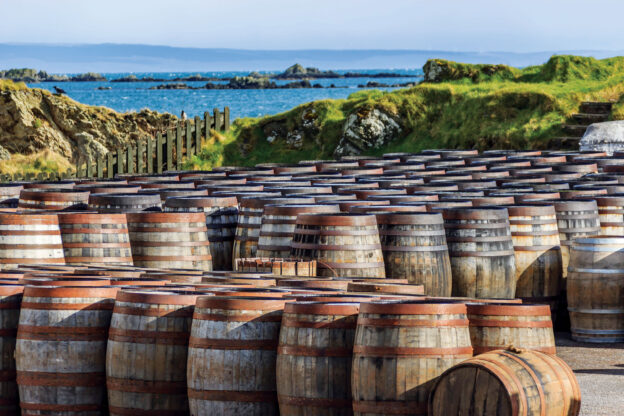Every cask loses liquid during maturation. Distillers call this the Angel’s Share. It is evaporation through the staves, but it is not only a loss of volume. The changing mix of alcohol, water and air inside the cask quietly rewrites flavour.
Temperature, humidity, air flow, cask size and warehouse style all change how fast evaporation happens and what is lost. In humid, cooler stores the spirit tends to lose more ethanol and hold water. In hot, drier stores water can be lost faster than ethanol. That shift matters because alcohol and water extract different things from oak and drive different reactions over time.
Ethanol loss: When ethanol escapes faster than water, the alcohol by volume (ABV) falls. Lower ABV favours extraction of water soluble compounds such as ellagitannins, gallic acid and vanillic acid. These add gentle vanilla, light nuttiness and woody spice. The overall profile usually feels softer.
Water loss: When water evaporates faster, the ABV rises. Higher ABV pulls more alcohol soluble compounds such as whisky lactone, vanillin and longer chain esters. Expect richer vanilla, coconut and riper fruit notes like apple and pineapple from esters such as ethyl hexanoate.
Flavour concentration: Each year there is less liquid in the cask. What remains becomes more intense. Vanillin, furfural and long chain esters stand out more clearly. Older casks can feel almost syrupy on the palate.
Oxidation: Evaporation creates headspace and oxygen enters through the wood. Oxygen turns ethanol into acetaldehyde and then acetic acid. Acids and alcohols react to form fruity esters. Phenolic smoke softens into leather, spice and dried fruit.
Volatile shift: Lighter aroma molecules leave the cask more readily. Bright esters such as ethyl butyrate and isoamyl acetate, and aldehydes like acetaldehyde, can drop away. Heavier, more persistent aromas then take the lead.
pH drift: Acetic acid, with smaller roles from formic and succinic acids, accumulates over time. pH falls slightly. This changes extraction rates from oak and nudges oxidation pathways, adding complexity.
The Angel’s Share is more than a poetic loss. It is one of the main forces that decides whether a spirit leans fruity, spicy, nutty or rich. In Scotland it may mean a slow, steady transformation over decades. In Jamaica it can mean rapid concentration and bold flavour development within a few short years. Years do not translate one to one – the chemistry takes a different path, and so does the flavour.
John Angus is a UK based chemist and whisky educator who shares the science of flavour through his newsletter, The Distilled Edit. Connect on LinkedIn at http://linkedin.com/in/john-angus, read the newsletter at https://www.linkedin.com/newsletters/the-distilled-edit-7339239882814308352, and explore whisky flavour infographics at https://payhip.com/SpiritChemistry.


